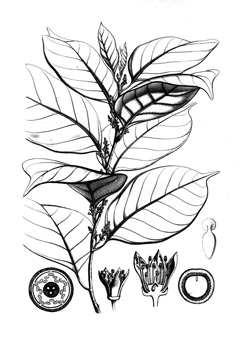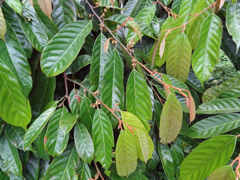 |
|
https://edibleplants.org/ |
 |
| Scamperdale flickr |
Translate this page:
Summary
Coula edulis or African Walnut is an evergreen tree native to western Africa with a dense crown and grows up to 38 m in height. The leaves are simple and arranged alternately. The flowers are greenish yellow with four or five petals. The nut is an ellipsoidal drupe, smooth and red or green in colour. It is also known as Gabon nut. Plant parts have various uses. The nut is eaten raw or cooked. It can also be fermented and used as a condiment. The wood is very hard, heavy, and durable. It is resistant to attacks of fungi, termites, and marine borers. It is used in turnery, heavy carpentry, piles for bridges, etc.
Physical Characteristics

 Coula edulis is an evergreen Tree growing to 20 m (65ft) by 20 m (65ft) at a medium rate.
Coula edulis is an evergreen Tree growing to 20 m (65ft) by 20 m (65ft) at a medium rate.
See above for USDA hardiness. It is hardy to UK zone 10.
Suitable for: light (sandy), medium (loamy) and heavy (clay) soils and prefers well-drained soil. Suitable pH: mildly acid, neutral and basic (mildly alkaline) soils and can grow in very acid and very alkaline soils.
It can grow in semi-shade (light woodland) or no shade. It prefers moist soil.
UK Hardiness Map
US Hardiness Map
Synonyms
Coula cabrae Wildem et Th. Dur.
Plant Habitats
Edible Uses
Edible Parts: Oil Seed
Edible Uses: Condiment Oil
Seed - raw or cooked[ 46 , 63 ]. A good dessert nut with a pleasant taste[ 63 ]. The oily kernel has a taste comparable to that of a chestnut or hazelnut[ 303 ]. It can be eaten raw, grilled or boiled[ 303 ]. The seed contains 50% oil, of which 87% is oleic acid[ 63 , 303 ]. The seed is also fermented and used as a condiment[ 46 ]. The spherical fruit is about 3cm long[ 335 ].
References More on Edible Uses
Medicinal Uses
Plants For A Future can not take any responsibility for any adverse effects from the use of plants. Always seek advice from a professional before using a plant medicinally.
None known
References More on Medicinal Uses
The Bookshop: Edible Plant Books
Our Latest books on Perennial Plants For Food Forests and Permaculture Gardens in paperback or digital formats.

Edible Tropical Plants
Food Forest Plants for Hotter Conditions: 250+ Plants For Tropical Food Forests & Permaculture Gardens.
More

Edible Temperate Plants
Plants for Your Food Forest: 500 Plants for Temperate Food Forests & Permaculture Gardens.
More

More Books
PFAF have eight books available in paperback and digital formats. Browse the shop for more information.
Shop Now
Other Uses
Charcoal Furniture Oil Wood
Other Uses: The heartwood is dark red or violet brownish-red with dark brown veins; it is clearly demarcated from the 3 - 4cm wide band of pinkish-brown sapwood. The texture is fine; the grain straight or interlocked, sometimes wavy. The wood is very hard, very heavy, elastic, and very durable, resisting water well and resistant to fungal and insect attack, particularly termites and marine borers. It seasons slowly, with a high risk of distortion and checking; once dry it is moderately stable in service. The wood has a fairly high blunting effect upon tools, stellite-tipped and tungsten carbide are recommended; it polishes well; is easy to work, but has the disadvantage of being liable to shake and crack; it takes nails and screws well so long as it is pre-bored; gluing is correct for interior use only. In great demand, the wood is used in turnery and as a substitute for mahogany, as well as for heavy carpentry, industrial flooring, piles for bridges and railway ties[ 46 , 63 , 303 , 418 , 848 ]. The wood produces a suitable charcoal[ 303 ].
Special Uses
Carbon Farming Food Forest
References More on Other Uses
Cultivation details
Management: Standard Regional Crop
A plant of the hot, humid, lowland tropics. It grows best in areas where annual daytime temperatures are within the range 25 - 35°c, but can tolerate 20 - 40°c[ 418 ]. It prefers a mean annual rainfall in the range 1,000 - 2,000mm, but tolerates 800 - 2,500mm[ 418 ]. Succeeds in full sun and in partial shade[ 418 ]. Shading is beneficial when plants are young[ 303 ]. The tree has no special soil requirements[ 303 ]. Prefers a well-drained soil[ 418 ]. Prefers a pH in the range 5 - 6.5, tolerating 4.5 - 7[ 418 ]. Fruit is normally borne plentifully in the wild[ 303 ].
Carbon Farming
-
Management: Standard
Plants grow to their standard height. Harvest fruit, seeds, or other products. Non-Destructive management systems.
-
Regional Crop
These crops have been domesticated and cultivated regionally but have not been adopted elsewhere and are typically not traded globally, Examples in this broad category include perennial cottons and many nuts and staple fruits.
References Carbon Farming Information and Carbon Sequestration Information
Temperature Converter
Type a value in the Celsius field to convert the value to Fahrenheit:
Fahrenheit:
The PFAF Bookshop
Plants For A Future have a number of books available in paperback and digital form. Book titles include Edible Plants, Edible Perennials, Edible Trees,Edible Shrubs, Woodland Gardening, and Temperate Food Forest Plants. Our new book is Food Forest Plants For Hotter Conditions (Tropical and Sub-Tropical).
Shop Now
Plant Propagation
Seed - Because of the hard integument, germination is rather poor and may take up to a year[ 303 ].
Other Names
If available other names are mentioned here
Coula edulis or African Walnut. Also known as: Attia, Bodwe, Ekom, Emumu, Engom, Ewome, Ewoumeu, Fiya-towo, Gaboon-nut, Ivianlegbe, Kommol, Kumen, Kumini, Kumumu, Kumunu, Mengom, Ndokei, Ngoma, Noyer du pays, Slah, Sweh, Tokei, Udi, Woula,
Native Range
AFRICA: Cameroon, Democratic Republic of the Congo, Congo, Gabon, Equatorial Guinea, Benin, Côte D Ivoire, Ghana, Liberia, Sierra Leone.
Weed Potential
Right plant wrong place. We are currently updating this section.
Please note that a plant may be invasive in one area but may not in your area so it's worth checking.
None Known
Conservation Status
IUCN Red List of Threatened Plants Status : This taxon has not yet been assessed

Growth: S = slow M = medium F = fast. Soil: L = light (sandy) M = medium H = heavy (clay). pH: A = acid N = neutral B = basic (alkaline). Shade: F = full shade S = semi-shade N = no shade. Moisture: D = dry M = Moist We = wet Wa = water.
Now available:
Food Forest Plants for Mediterranean Conditions
350+ Perennial Plants For Mediterranean and Drier Food Forests and Permaculture Gardens.
[Paperback and eBook]
This is the third in Plants For A Future's series of plant guides for food forests tailored to
specific climate zones. Following volumes on temperate and tropical ecosystems, this book focuses
on species suited to Mediterranean conditions—regions with hot, dry summers and cool, wet winters,
often facing the added challenge of climate change.
Read More
Expert comment
Author
Baill.
Botanical References
Links / References
For a list of references used on this page please go here
A special thanks to Ken Fern for some of the information used on this page.
Readers comment
| Add a comment |
|
If you have important information about this plant that may help other users please add a comment or link below. Only comments or links that are felt to be directly relevant to a plant will be included. If you think a comment/link or information contained on this page is inaccurate or misleading we would welcome your feedback at [email protected]. If you have questions about a plant please use the Forum on this website as we do not have the resources to answer questions ourselves.
* Please note: the comments by website users are not necessarily those held by PFAF and may give misleading or inaccurate information.
To leave a comment please Register or login here All comments need to be approved so will not appear immediately.
|
|